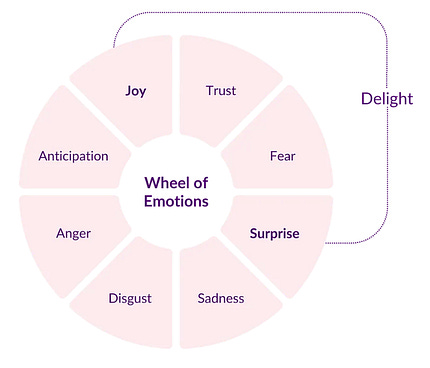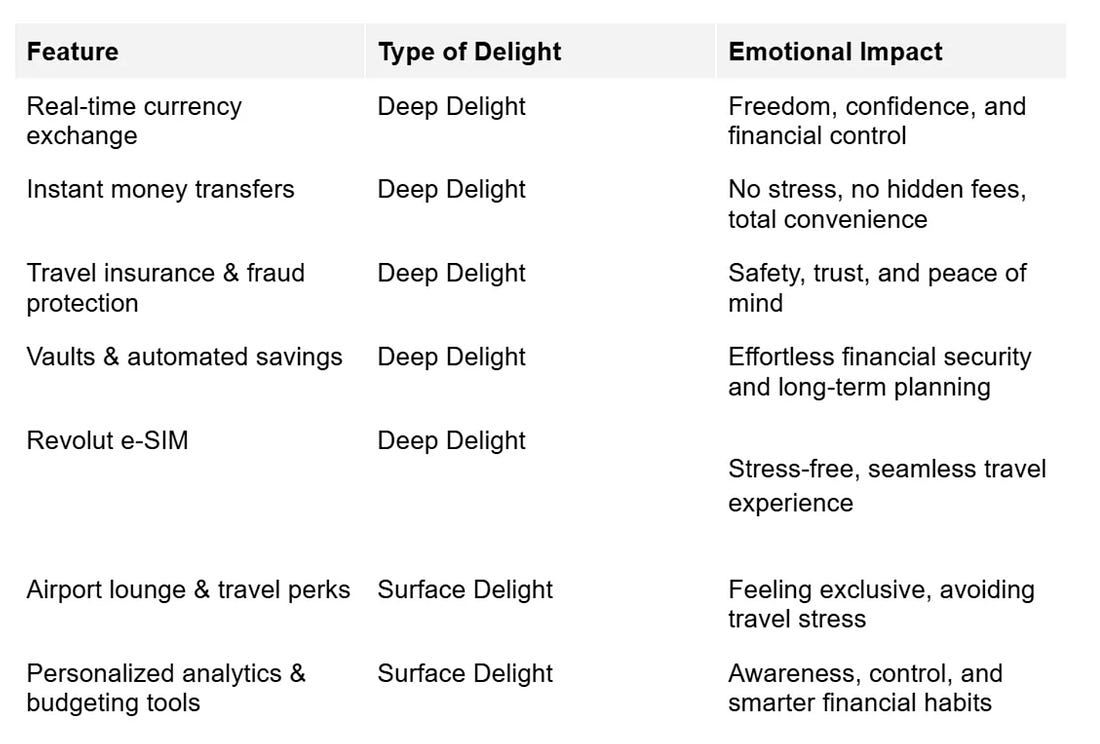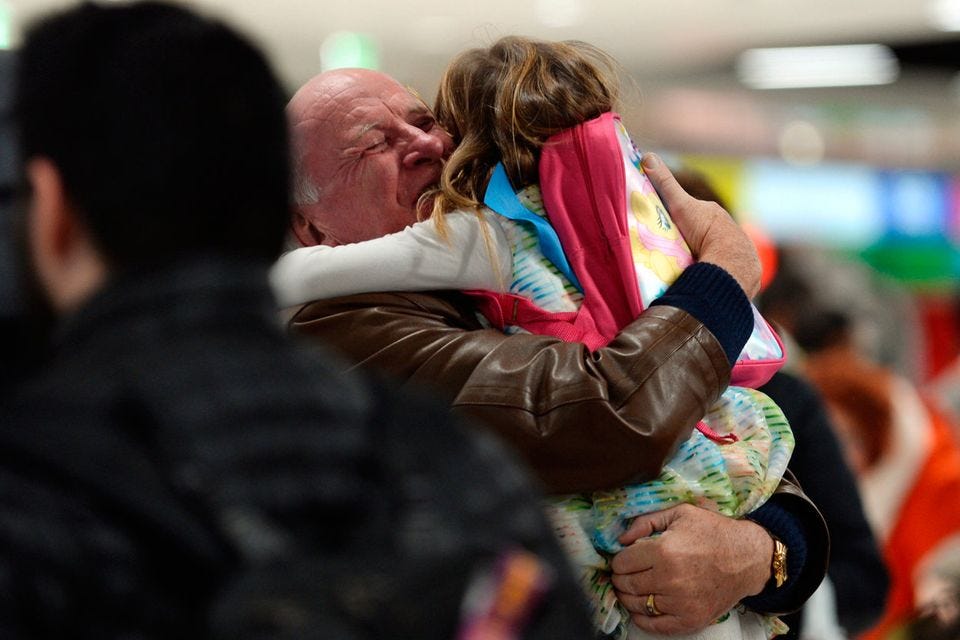Travel Tech Essentialist #186: Delight
- Mauricio | Travel Tech Essentialist <traveltechessentialist@substack.com>
- Hidden Recipient <hidden@emailshot.io>
Delight is easy to recognize, but harder to create. It’s emotional, personal, and often unexpected. The best products, brands, and experiences deliver it with remarkable consistency. This edition explores delight as a craft. From the psychology behind it, to the systems that enable it, to the small human touches that make it unforgettable. Special thanks to OAG for sponsoring this edition of the newsletter:
1. Delight = Joy + SurpriseIn his book Theories of Emotion, psychologist Robert Plutchik describes non-core emotions as combinations of two core ones. Delight, he notes, is the result of joy and surprise. When a product delivers both, it creates an emotional response that users remember, talk about, and return for. In The Theory Behind Delight, Nesrine Changuel brings this idea into product management. She explains how to design for delight by celebrating user wins, introducing thoughtful surprises, aligning joy with user goals, and resisting gimmicks that don’t serve a real purpose. The result is products that feel useful and emotionally alive. 2. The science of delightWith a PhD in physics and an impressive track record of leading products at Google, Spotify, and Microsoft, Nesrine Changuel treats customer delight as a product discipline; a repeatable, measurable input to retention, engagement, and brand value. On Lenny’s podcast, Nesrine shared a clear framework for building delight into products. A few takeaways:
3. Revolut’s travel eSIM: a clear example of product delightIn this post, Nesrine Changuel highlights how Revolut earns loyalty and delights its customers by anticipating user needs, even in areas where users don’t expect it. Most people wouldn’t look to a banking app for mobile data, but Revolut identified a natural pain point among its customers and solved it directly. Revolut’s travel eSIM feature allows its customers to activate mobile data instantly from the app. It’s simple, fully integrated, and turns a typically frustrating moment into one that feels effortless and magical. A well-timed, unexpected solution like this builds trust and strengthens the emotional connection with the brand. Nesrine calls this Deep Delight: features that solve real, often overlooked problems and make users feel seen, safe, and in control. These aren’t surface touches. They shape the experience in ways people remember and return for. She shows how Revolut has evolved from a currency exchange tool into a complete travel and finance companion by doing three things well:
4. Designing objects of desireEric Ryan, founder of Method (home cleaning), Olly (vitamins), and Wellie (bandages), has built billion-dollar consumer brands by designing around emotional connection. His approach is a masterclass in building delight through packaging, positioning, and surprise. In a recent podcast, Eric lays out the playbook:
If you’d rather read than listen, here’s Eric’s playbook in text form. 5. What delight is notSometimes the clearest way to explain a delightful experience is to show what happens when it’s missing. This short Instagram video by comedian Jake Lambert hilariously walks through the strange, frustrating, and totally avoidable design decisions in many hotel rooms. Every design choice shapes the user experience, for better or worse.
6. Intuition meets intention
Will Guidara built the world’s best restaurant not just on food, but on creating a consistent sense of delight. His guiding idea was that excellence rarely happens by accident. It’s planned. Guidara’s team didn’t rely on “good instincts” alone. They noticed details and built habits around them. When a couple mentioned their honeymoon destination, dessert became a themed surprise. When a guest missed out on a hot dog at a ball game before dinner, the server went out, bought one from a street vendor, and the kitchen transformed it into a white-tablecloth version. When staff overheard a diner worrying about their parking meter, someone quietly went out and fed it so the guest wouldn’t have to interrupt their dining experience or get a ticket. None of that came from policy. It came from a culture of noticing and acting. Intuition might spark a great idea, but intention is what makes it repeatable. Most great experiences aren’t effortless. They just feel that way. Behind the scenes, someone paid close attention and cared enough to follow through. As Guidara puts it, intuition is knowing what would delight someone; intention is doing something about it. The intersection of those two is where loyalty is built, and where magic happens. 7. The platform and the curatorIn this blog post, Seth Godin draws a clear distinction between platforms that passively serve the algorithm and curators who actively shape better, more relevant experiences. He points to companies like Netflix, which succeed by leaning into curation and making intentional, taste-driven choices that help people find things that matter. On the other hand, he calls out travel sites that rank flights with hidden fees above more transparent options, or Amazon surfacing junk because the algorithm rewards it. When platforms stop curating, the experience suffers, and users notice. It ties directly to how we think about product delight. Algorithms can scale a system, but they can’t replace judgment. What you choose to show, hide, or prioritize shapes the whole journey. You have to care, and you have to choose.
Of course, curation isn’t without risk. When done poorly, it can lead to gatekeeping or groupthink, especially when platforms silence divergent views under the banner of quality or safety. The goal isn’t to control the conversation. It’s to guide discovery with care, intention, and transparency. 8. The superpower of youthI spend a small but not meaningless part of my year mentoring and teaching entrepreneurship students at Tulane, IESE, and Stanford. One message I repeat often is that people are more willing to help than you might expect when you’re just starting out. This short clip from Palmer Luckey (founder of Oculus and Anduril) captures that idea perfectly. He talks about how age is a kind of privilege, but it doesn’t last forever. When you’re early in your journey, people who are incredibly busy or accomplished will often make time for you. But it’s not just about sending a cold email. It’s about putting in the time to be thoughtful, specific, sincere, and original. When someone shows they’ve done the work, it stands out. And often, that’s enough to earn a response, even from someone who’s incredibly busy. Too many students hold back from reaching out to someone they admire. They assume they’ll be ignored. But if you’re intentional and respectful of someone’s time, it’s surprising how often the answer is yes. This doesn’t just apply to students. Entrepreneurs early in their journey often underestimate how much others want to help. It’s also a way to stand out from the crowd that blends in. Most people follow the expected path. But delight often lives in the unexpected; in finding a side door most people wouldn’t dream of knocking on.
9. Emotional connection 101Isaac French wrote a short post that captures a real-world moment of emotional connection: standing near the arrivals gate at an airport, watching people reconnect with the ones waiting for them. We’ve all enjoyed those moments ourselves. But once in a while, it’s worth stepping back and paying attention to it in others. Next time you’re at an airport, or anywhere people are meeting again, take a minute to watch what that moment looks and feels like. The airport equivalent of stopping to smell the flowers.
10. Your moment of delightBefore we wrap up, a quick question: Delight is emotional, personal, and often surprising. When has it hit hardest for you while traveling?
P.S.Enjoyed something in this issue?If a line sparked an idea, made you smile, or reminded you of someone, please forward the newsletter, post a quote on social media, or just text it to a friend. That’s how this community grows: one thoughtful share at a time :-) 👉 New readers can sign up here P.S. Join 1,500+ Travel Leaders at Travel Trends AI Summit V2Our friends at the Travel Trends Podcast are back with V2 of the world’s largest virtual summit on AI in travel, happening October 28–29. Over 80 speakers will explore how AI is transforming every corner of the travel industry. Tickets are normally $149, but with this exclusive Travel Tech Essentialist code Grab your ticket now before prices go up. And don’t forget to use discount code TTETT Travel Tech Essentialist Job Board xx→ Explore all 1299 open roles on the Travel Tech Essentialist Job Board now.
📩 For monthly updates on the latest roles, subscribe to the Travel Tech Jobs newsletter Raising a round?If you are a startup looking to raise a round (from pre-seed to Series D), I can help (for free). Travel Investor Network is a private platform where I recommend innovative travel startups to investors and innovators. If you’re interested, please start by completing this form. And, as always, thanks for trusting me with your inbox. See you around, Mauricio Prieto |
Similar newsletters
There are other similar shared emails that you might be interested in:






